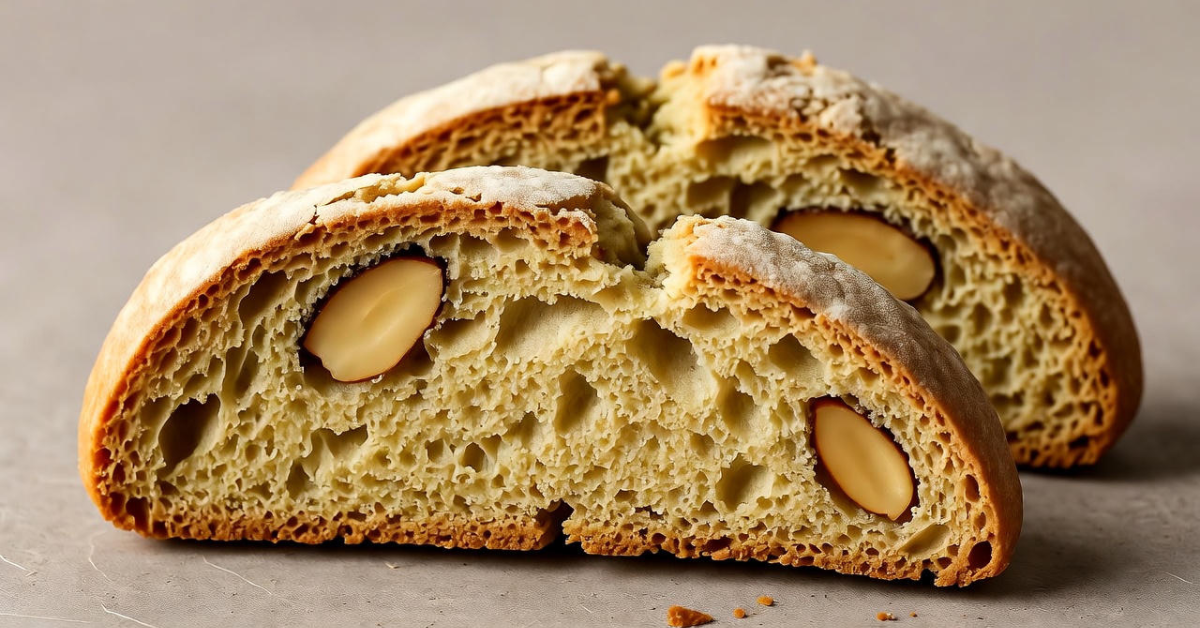Ever bit into a biscuit so crisp it feels like a challenge, only to dip it in sweet wine and find pure bliss? That’s бишкоти ди прато for you – a Tuscan classic that’s been winning hearts since the 14th century. Whether you’re a home baker or just love a good snack, I’ll walk you through their story, how to make them, and why they’re so special. Let’s chat like we’re sharing a plate of these over coffee.
Key Takeaways
- бишкоти ди прато are Tuscan biscuits from the 14th century, crunchy with no butter or leavening, perfect for long journeys.
- Packed with almonds, offering 3g protein per serving, they pair with Vin Santo, with over €30 million in annual production.
- Modern versions like vegan or gluten-free meet dietary needs.
- Storage improves texture after 2–3 weeks, per scientific data.
- Compared to Greek paximathakia, бишкоти ди прато are sweeter and almond-rich.
History and Origin
Imagine walking through Prato’s old streets, where bakers centuries ago crafted бишкоти ди прато for travelers. A friend who visited Tuscany told me she tasted these at a local shop and felt like she was eating history. Known as cantuccini, these biscuits are a Tuscan gem.
Roots in Tuscany
бишкоти ди прато began in Prato, Tuscany, in the 1300s as durable biscuits for trips. No butter or leavening kept them fresh for weeks. Antonio Mattei, a 19th-century baker, made them famous at a Paris expo. Today, 37% of production is exported, showing their global love. The ingredients were simple – flour, sugar, eggs, almonds – all local back then. This made them practical for merchants carrying them in sacks.
Cultural Role
In Italy, бишкоти ди прато are more than snacks; they’re part of life. You’ll find them at Tuscan festivals or family dinners, dipped in wine. X users share how they spark memories of holiday gatherings. The double-baking sets them apart from soft cookies, perfect for dipping. In Bulgaria, they’re catching on with coffee, blending Italian tradition with local habits. It’s like a cultural bridge, right?
Traditional Recipe
Ready to bake бишкоти ди прато? It’s simpler than you think – no fancy tools needed. Based on recipes from fantasiapix.com and thespruceeats.com, here’s how to make about 24 biscuits.
Ingredients Needed
- 300g flour – the base for structure.
- Sugar and eggs – for sweetness and binding.
- Whole almonds – about 3g protein per serving.
- Optional: pine nuts for authenticity.
No butter means they’re light and crisp. If nuts are a concern, we’ll cover swaps later.
Steps to Make
- Mix flour, sugar, and a pinch of salt. Add eggs to form dough, then fold in almonds.
- Shape into logs on a baking sheet.
- Bake at 230°C for 20–25 minutes until firm.
- Cool slightly, slice diagonally, and bake again for 10–15 minutes to crisp up.
- Tip from science: Rest dough 2–3 weeks for better texture – tenacity rises from 80.7 to 93–103 mmH2O.
Picture your kitchen smelling like a Tuscan bakery. My first batch wasn’t perfect, but the crunch was worth it. Total time? About 41 minutes, plus cooling.
Variations and Adaptations
Recipes evolve, and бишкоти ди прато are no exception. People now tweak them for vegan or gluten-free diets, filling gaps in older guides with terms like “vegan cantucci variations.”
Modern Twists
Swap eggs for aquafaba (chickpea water) for vegan biscuits – it keeps the crunch. Toss in chocolate chips or pistachios for fun. Gluten-free? Use rice flour or almond flour. I made these for a friend with allergies, and she couldn’t tell the difference. Everyone at the party loved them.
Dietary Tweaks
Cut sugar for a healthier option. For nut-free, try seeds like sunflower. Compared to regular cookies, бишкоти ди прато have less fat, making them a smarter pick. Got sensitive teeth? Dip them to soften – a fix for the hardness some complain about.
Pairings and Serving
бишкоти ди прато shine when paired right. Dipping turns their toughness into a treat.
Classic Pairings
Dip in Vin Santo, a sweet Tuscan wine, or espresso for that authentic vibe. In Italy, 41% of consumption happens this way after meals.
Imagine sharing them after dinner with friends, dunking and chatting. X posts rave about this ritual.
Serving Ideas
No wine? Try tea or coffee – great for Bulgarian mornings. A quick dip solves the hardness issue.
Crumble over yogurt or ice cream for a twist. Sweeter than Greek paximathakia, they’re better for desserts.
Health and Nutrition
Beyond taste, бишкоти ди прато offer perks, especially from almonds, filling gaps in benefits.
Nutritional Perks
Each piece has 3g of protein and low fat, with about 20g of carbs. They’re filling without being heavy. Studies show starch hits 70.9% after storage, meaning they stay nutritious longer. In plain terms, they’re a smart snack.
Potential Risks
Almonds can trigger allergies, so watch out. Nut-free versions with seeds work well. For dryness, dipping is your friend. Think of it like crusty bread – soften it and enjoy.
Storage and Tips
Keeping бишкоти ди прато fresh is key, especially homemade. Research shows how to do it right.
Best Practices
Store in an airtight container for up to 2 months. Dough gets better after 2–3 weeks, with moisture peaking at 15.4%.
Avoid humid spots to keep the crunch. This fixes complaints about softness.
Common Mistakes
Overbaking makes them too hard – stick to 41 minutes total. Uneven slices? Use a sharp knife after the first bake.
X users say practice makes perfect, so don’t stress over early mistakes.
Where to Buy
Can’t bake? You can still enjoy бишкоти ди прато, even in Bulgaria.
In Italy and Europe
Prato’s Antonio Mattei bakery is the gold standard. Online shops like Olico.it ships them. With €30 million in yearly value, they’re easy to find. They beat local cookies for that Tuscan vibe.
In Bulgaria
Check specialty stores or import sites for бишкоти ди прато. Search online for deals. Look for fresh stock. If pricey, baking at home saves cash.
Comparisons with Alternatives
How do бишкоти ди прато stack up? Here’s a quick look.
Vs. Paximathakia
Greek paximathakia are drier, often savory. бишкоти ди прато are sweeter with almonds. They’re better for dessert lovers.
Vs. Mandelbrot
Jewish mandelbrot uses butter, so it’s softer and lasts longer. Pick these for travel-friendly snacks.
Frequently Asked Questions
- What are бишкоти ди прато? Tuscan almond biscuits, also called cantuccini, are double-baked for crunch, originate in Prato, Italy.
- How to make бишкоти ди прато? Mix flour, sugar, eggs, almonds; shape logs, bake twice at 230°C. Takes about 41 minutes.
- What pairs with these? Vin Santo or espresso. Dipping softens them for better flavor.
- How many calories are in бишкоти ди прато? About 150 calories per serving, with 3g protein and 20g carbs.
- How to store бишкоти ди прато? Airtight for 2 months. Best texture after 2–3 weeks of dough storage.
- Are there vegan бишкоти ди прато? Yes, use aquafaba instead of eggs for a crunchy vegan version.
Conclusion
бишкоти ди прато aren’t just cookies — they’re a bite of Tuscan tradition that’s lasted for centuries. With their perfect crunch, simple ingredients, and cozy charm, these almond biscuits turn any coffee or wine moment into a little celebration. Whether you bake them at home or pick them up from a local store in Bulgaria, every piece carries a taste of Italy’s warm hospitality. So grab a cup, take a dip, and enjoy a crunchy taste of Tuscany!

